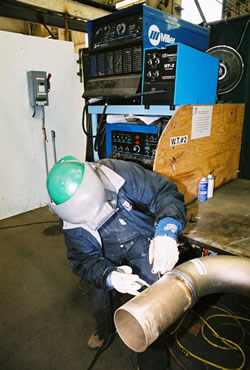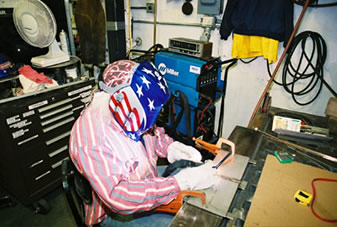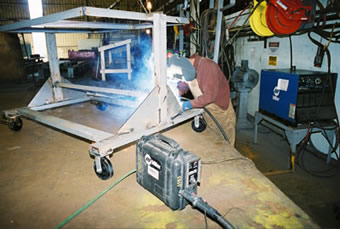Executive Summary
As part of company's effort to adopt "5s" lean manufacturing principles, Todd Pacific Shipyard took stock of its welding technology and traded older, larger, and inefficient welding equipment for compact, efficient new inverters and wire feeders from Miller Electric Mfg. Co. As a result, it has saved space, energy and rework time.
Spending weeks or months on the open seas can wear on the soul of anyone. Even the heartiest sailor welcomes a stop in port to build strength for the next trek out to sea. The ships that carry these men and women, whether commercial haulers, military vessels or commercial cruise ships, require the same attention. A trip to the shipyard provides the opportunity for much needed welding repairs and improvements that can't be made while on the high seas.
Todd Pacific Shipyards Corporation, located in the deep waters of Puget Sound, Port of Seattle, Washington, is one such refuge for some of the world's largest ships. Throughout the Pacific Rim, Todd Pacific is known for its ability to take on repair, maintenance, conversion and building jobs of all sizes and descriptions. Todd Pacific promises its customer that, "We do them right, and get them done fast." Todd Pacific is equipped with specialized skills and equipment so ship owners won't need to seek additional specialists to complete parts of job. The company is fully prepared to handle every shipyard function customers expect—and a long list of other services they are likely to require.
With 100-plus years of ship repair and construction under its belt, Todd Pacific understands the importance of evolving with technology. The company recently adopted "5S" lean manufacturing techniques to streamline workflow through all facets of the shipyard (5S—Sort, Simplify, Sweep/Shine, Standardize, Sustain—is a technique for visual work place organization and standardization where any tools and materials not needed for the job are removed). As part of this effort, Todd Pacific took stock of its welding technology and traded older, larger, and inefficient welding equipment for compact, efficient new inverters and wire feeders from Miller Electric Mfg. Co. As a result, it has saved space, energy and rework time.
Copper Nickel Pipe Welding Calls for Strong Welding Combo
Recently, when an aircraft carrier from the U.S. Naval fleet docked in Bremerton, Todd Pacific spent three months overhauling the low-pressure steam and water lines that serve the ship's living quarters and inhabitable areas. With more than 5,000 joints to be assembled of .095 in. wall 90-10 copper nickel tubing, ranging from 1/2 to 3 inches in diameter, Todd Pacific relied on Maxstar® 200 DX DC TIG/Stick inverters and Syncrowave® 350 LX AC/DC TIG welders.
90-10 copper nickel is a commonly used alloy in marine applications for its resistance to corrosive effects of salt water and bio-fouling. According to Ken Johnson, welding supervisor for Todd Pacific's pipe shop, each particular joint requires good cleaning.
"With copper nickel pipe," he says, "we clean an inch back from the weld with a grinder, flapper wheel and/or abrasive cloth to remove any oxidation to ensure a good, clean weld." Whenever possible, Todd Pacific tries to weld this process pipe in a socket weld configuration because this creates a lap joint. Lap joints, compared to butt joints, do not require back-purging (completely filling the pipe with argon to displace the air; it improves weld quality on butt joints, but it is a costly and time-consuming process).
Once prepared, the pipe fitters tack weld the pipe in place using one of eight Maxstar 200 inverters. These inverters weight 37 lbs. and measure just 13.5 high x 7.5 wide x 17.5 inches deep, which enables Todd Pacific to mount them underneath the welding table (see Fig. 1).
 |
Fig. 1 The compact space of the Maxstar 200 DX enabled Todd Pacific mount it underneath the welding table for better organization in the tack welding area of its pipe shop.
|
"When putting lean manufacturing practices to work in our tacking operation, we specified the need for a small, compact DC TIG inverter," says Johnson. "Given the massive amounts of stainless steel and copper nickel that flow in and out of the Pipe Shop floor, the inverters free up more space."
The Maxstar 200DX features 1 to 200 amp welding output, Lift-Arc™ or high-frequency arc starts, digital meters, programmable parameters and Auto-Line™ primary power management technology. Auto-Line provides Todd Pacific with two benefits. First, it enables them to connect the Maxstar 200s to the pipe shop's three-phase 440 volt primary power because Auto-Line accepts any type of primary power, from 120 to 460 V, single- or three-phase. Conventional TIG units can only accept single-phase power, which is less efficient than three-phase power.
For example, on a three-phase 440V primary line, the Maxstar 200 requires just 5.3 amps of power to weld at 175 amps/17 volts. On a single-phase 230V primary, Auto-Line still enables the Maxstar to draw a meager 17.4 amps. Compare this to a modern, but conventional TIG welder such as Miller's Syncrowave 180 SD. To produce a weld output of 150 amps at 26 V, it requires 27 amps on 460 V primary and 54 amps on 230 V primary (single-phase only).
Previously, the pipe fitters used a competitive brand of TIG inverters, but the manufacturer could not provide parts and components in a timely manner, which affected productivity.
"One of my biggest needs is equipment availability. If I have a welder that goes to maintenance, I'm going backwards," says Johnson. "I have to have a machine that's ready to roll. That's behind the service concept that our distributor, Tom McGowan of Pacific Welding Supplies, implemented here for Miller equipment."
McGowan, Pacific Welding's director of business development, says that, "If a Miller machine needs service, we come in and get it for them and have it serviced under Miller's three-year warranty. Rather than having their maintenance person tied up with a welder, he can work on something else."
Throughout the fast-paced three months of overhauling the low-pressure steam and water lines, the new Maxstar 200s performed without fail.
"We haven't had any downtime, and that makes us more productive because it keeps material flowing through the shop on schedule," says Johnson.
From Tacking to Finished Welding
Once tacked in place, the 90-10 copper nickel pipe goes to the welding stations. While the welding stations would have also benefited from the space and energy savings of TIG inverters, Johnson also recognized another important factor of productivity: operator comfort and familiarity with equipment. For that reason, he chose to replace old Syncrowave 300s with the new Syncrowave 350 LX (Fig. 2).
 |
| Fig. 2 Todd Pacific welder Pete Ballena uses a Syncrowave 350 LX to weld 90-10 copper nickel pipe. The unit's digital meters enable him to easily set parameters. |
This unit features Miller's exclusive Syncro Start™ technology, giving the operator three starting conditions that optimize each given application based on tungsten diameter and material thickness. Digital meters allow for greater accuracy and repeatability by clearly displaying actual and preset amperage and voltage levels. Built-in shielding gas pre-flow and post-flow help consistently keep contaminants out of the weld pool. The Syncrowave 350LX also features a "last procedure recall" function that automatically recalls the last procedure set-up when switching polarities to simplify process changes. Each of these features helps ensure that the operators in the production cells of the shipyard's pipe shop have equipment that, by design, helps improve weld quality.
Along with being extremely resistant to corrosion, 90-10 is very heat sensitive, thus having a higher potential for distortion. Welder Pete Ballena (see Fig. 3) explains his technique to weld this pipe: "I rest the cup of my torch directly on the pipe and walk the cup forward, moving from side-to-side on the joint. I keep the filler rod in the weld pool in the arc cone at all times [which helps remove heat]. I'm not dipping it in and out; it's just a steady working it around the leading edge puddle."
To complete each weld, Ballena runs the Syncrowave 350 LX at 80 to 150 amps with filler metal RN67 (recommended alloy match for 90-10) in diameters of 1/16 and 3/32 in., depending on the thickness of each pipe. A two-percent thoriated tungsten (3/32 in.) and 100 percent argon shielding gas are used.
 |
| Fig. 3 Todd Pacific welder Pete Balena's "walking the cup" technique produces outstanding TIG bead quality on this 90-10 pipe. Note the "socket weld" joint design that eliminates the need for back-purging. |
"Keep your weld clean and stay within your parameters," advises Johnson. "If a welder can TIG weld stainless steel, they are well on their way to being able to TIG weld copper nickel."
Dynasty 300 DX Reduces Power Consumption; Provides New Level of Control
In the sheet metal shop of Todd Pacific, a variety of aluminum, stainless, copper nickel and other metals are used in building everything from vents and cabinetry to showers and lavatories. Sheet metal is generally defined as material less than 1/8-in. thick. Previously, 1970's era welding equipment was used in this shop's cells. These machines were very inefficient, using large amounts of primary power both during arc-on and idle cycles. This was one of the main reasons the company decided to upgrade to Miller's Dynast® 300 DX TIGRunner® systems. A TIGRunner features a cart-mounted welder, Coolmate 3 water cooler and Diamondback™ TIG torch (Fig. 4).
"The Dynasty 300 DXs draw considerably less power than the old machines we had in the sheet metal shop," says Jerry Edderington, Todd Pacific superintendent. "In a worst case scenario, an old machine would tie-up a 100-amp breaker all by itself. By replacing eight old machines with eight new machines, we could actually add more TIG welders without increasing the amperage capacity of the shop."
 |
Fig. 4 Even though space is limited in the welding stations at Todd Pacific's sheet metal shop, the Dynasty 300 DX in a TIGRunner configuration helps save space. This inverter's energy efficiency also reduced utility bills, while its low amperage draw enabled adding more welders to existing circuit breakers. |
This ability to draw less power (17 amp draw with the Dynasty 300 DX welding at 250 amps/30 volts compared to 50 to 95 amps with the older equipment) and the resulting reduction in power usage has proved to companies like Todd Pacific that this equipment can, over time, pay for itself.
"We can guarantee that there is cost savings just by the power draw alone," confirms Edderington. "Any time we can switch to an inverter like the Dynasty or Maxstar, we see savings in weight, power use and size, especially in our welding stations. We keep the TIG inverters under, or right next to, the welding table, so the guys can easily adjust parameters and processes while still keeping a clean and spacious working environment."
McGowan adds that, "Even though vintage 1970s or 80s TIG/Stick equipment may still produce a good arc, energy savings like Todd Pacific experienced ought to prompt shops to take a look at new inverter technology. In places where we have tested the power draw compared to old welders, switching to a Dynasty or Maxstar inverter can potentially save the customer $1,000 per year, per machine."
Featuring a rated output of 250 amps at 40 percent duty cycle, the Dynasty 300 improves energy efficiency compared to conventional TIG welders because it can use three-phase primary power (as well as single-phase and 50 or 60 Hz through its Auto-Link™ technology). However, to those who TIG weld aluminum, the most appealing benefit of the Dynasty inverter is its advanced squarewave technology.
The Dynasty 300 features an AC TIG weld output frequency range of 20-250 Hz and an extended balance control that allows adjusting the electrode negative (EN) portion of the cycle from 30 to 90 percent. By adjusting frequency and balance control, the Dynasty enables the operator to fine-tune the weld bead profile specifically for the application. This makes welding easier for the operator and can improve weld quality and reduce the amount of scrap or re-work.
"The ability to adjust the AC frequency helped reduce the learning curve for operators because they could minimize the heat affect zone on either side of the weldment. They learned to make a quality weld faster," says Johnson.
Another advantage of advanced squarewave technology is that it welds aluminum in the AC mode without the use of continuous high frequency (or HF. Conventional TIG welders require continuous HF to stabilize the arc when welding aluminum). HF can interfere with electronic equipment, such as computers and the controls in CNC machines.
"We don't have the high frequency problem with inverters that we had with the previous units," reports Edderington. "The programmable features are a plus, too. You can duplicate your settings without a lot of adjustment."
The Dynasty and Maxstar feature user-friendly digital controls that enable storing four weld procedures per process (e.g., four for AC or DC TIG and Stick). This includes start parameters to optimize arc starts for different applications and procedures for pulsed TIG (pulsed TIG is especially helpful for preventing warping on the thin stainless common in the sheet metal shop).
Portable SuitCase Wire Feeders Important to Production
While lightweight and compact, the TIG inverters discussed in this article stay in the pipe assembly and sheet metal shop welding cells. This is an important facet of 5S: every tool has its place. This helps ensure equipment availability and the efficient flow of work throughout the shop.
However, when it comes to flux cored fabrication and repair work or making welds in tight spaces, Todd Pacific need the mobility provided by the SuitCase® 8VS wire feeder. The company first tested this feeder in 2002 as part of the beta test from Miller. Commonly running off of a multiprocess inverter such as the XMT® 304 for portable work or Dimension™ 452 for shop work, Todd Pacific now uses 25 SuitCase 8VS units.
"The SuitCase 8VS offers some size advantages that the competition does not," says Johnson. "The lighter weight (23.5 lbs. empty, 33 lbs. with wire) is easier for our workforce to pack around versus the old, standard feeders, especially for operators who are slightly built."
The SuitCase 8VS has a rated output of 330 amps at 60 percent duty cycle, features an impact resistant, flame retardant protective case and measures 14.5 high x 6.5 wide x 15.6 in. deep. Todd Pacific tested the durability of the XMT/SuitCase 8VS combination when it recently welded the caissons (suspension bridge tower "foundations") for the new Tacoma Narrows Bridge. McGowan reports that, "The SuitCase 8VS feeders ran 50,000 lbs. of flux cored wire to complete that project, and they performed very well."
John Huertas, a welder in the sub-assembly shop, adds that, "I've used the SuitCase 8VS on pretty much everything and everywhere. In the shop, in a ship, out in the rain, and it's an excellent machine. It's especially easy because it's lighter and smaller. To weld in the bay of a ship, I have to go through a foot-and-a-half hole and then crawl 50 feet. I can get the SuitCase 8VS to my job area a lot faster.
Edderington adds, "On a 1,000-ft. ship that has 10 or 15 decks, you want to move your equipment as little as possible, or you want it to be as light as possible. With the ability to move lightweight inverters and wire feeders from compartment to compartment, it greatly improves our set-up and carry-out times."
Todd Pacific is all about improving speed and organization as it implements 5S and other lean manufacturing techniques. Rather than sudden, quantum leaps, improvements are made steadily and continuously.
Tom Cardiel, a welder in the sub-assembly shop, explains how a small change can produce a big savings. "This lean manufacturing event involves designing and building a weld positioner," he says. "We're creating single piece flow, which relates to how material is used" (see Fig. 5).
 |
Fig. 5 Todd Pacific welder Tom Cardiel uses the SuitCase 8VS feeder and a Dimension 452 welder to fabricate a weld positioner that will improve workflow, potentially reducing a three-hour job to 30 minutes. |
When Todd Pacific cuts material, instead of taking it from cell to cell, the positioner creates a single cell where the operators can cut and fabricate everything in one area. This reduces the number of times the material is handled.
"We'll probably reduce a two- or three-hour job to half an hour," says Cardiel. "5S is new for us, and we're having a lot of fun doing it."
"Buy-in to 5S has been almost 100 percent," says Johnson. "And as a result, we replaced aging equipment that had served its useful life with new Miller welders, and each step has resulted in big savings."